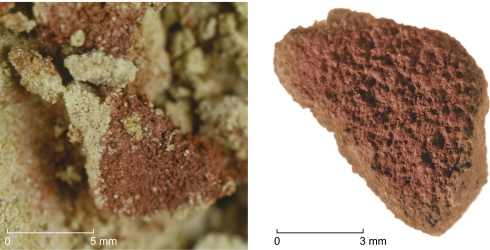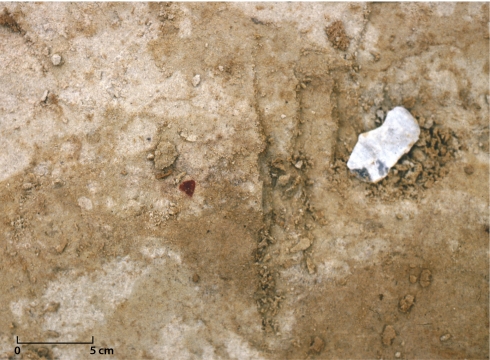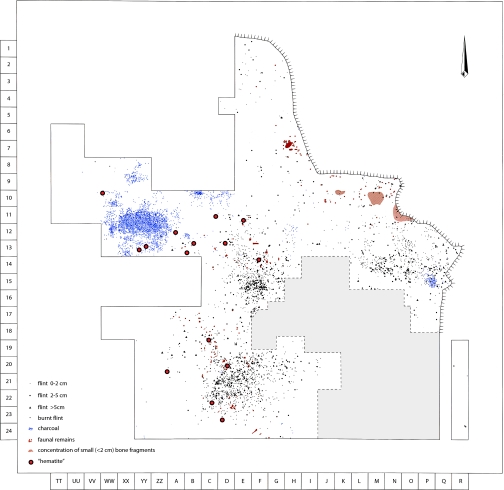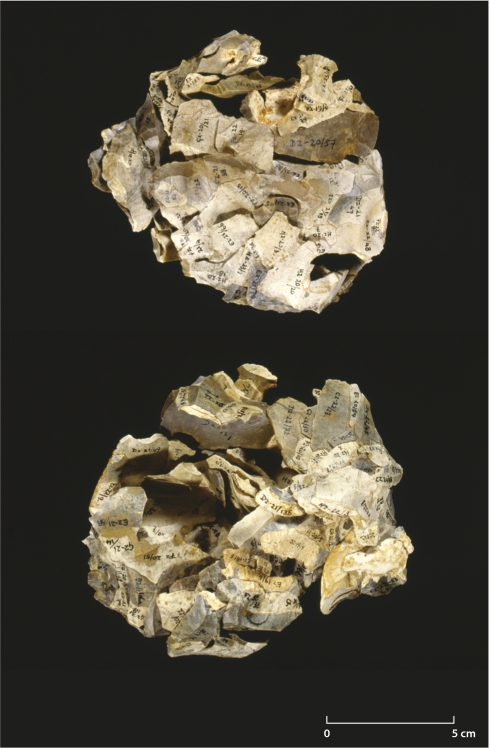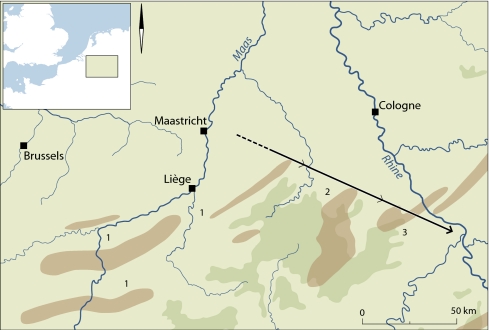Abstract
The use of manganese and iron oxides by late Neandertals is well documented in Europe, especially for the period 60–40 kya. Such finds often have been interpreted as pigments even though their exact function is largely unknown. Here we report significantly older iron oxide finds that constitute the earliest documented use of red ochre by Neandertals. These finds were small concentrates of red material retrieved during excavations at Maastricht-Belvédère, The Netherlands. The excavations exposed a series of well-preserved flint artifact (and occasionally bone) scatters, formed in a river valley setting during a late Middle Pleistocene full interglacial period. Samples of the reddish material were submitted to various forms of analyses to study their physical properties. All analyses identified the red material as hematite. This is a nonlocal material that was imported to the site, possibly over dozens of kilometers. Identification of the Maastricht-Belvédère finds as hematite pushes the use of red ochre by (early) Neandertals back in time significantly, to minimally 200–250 kya (i.e., to the same time range as the early ochre use in the African record).
Keywords: human evolution, paleolithic archeology, Middle Paleolithic, mineral pigments
Recent debates on Neandertal material culture have highlighted the fact that Middle Paleolithic sites occasionally contain pieces of manganese and iron oxides, interpreted as pigments, possibly for personal decoration (1, 2). Some have taken these findings an inferential step further and speculated on the “symbolic implications of body painting” and ochre use for our views on Neandertals (2). From the Upper Paleolithic record, red ochre is indeed well known for its use in cave paintings and in ritual burial contexts. More “mundane” or “domestic” uses of red ochre (derived from hematite, Fe2O3) are known from the ethnographic record of modern hunter-gatherers, for instance, as (internal and external) medication, as a food preservative, in tanning of hides, and as insect repellent (3–9). Archeological studies have identified ochre powder as an ingredient in the manufacture of compound adhesives (10). Thus, the use of iron oxides for “symbolic” purposes should be viewed as a hypothesis that needs to be tested, rather than simply assumed.
For Europe, a recent review (11) mentions more than 40 Middle Paleolithic sites with possible pigments from the Marine Isotope Stage (MIS) 6–3 range. These concern mostly manganese oxide finds and almost all sites date to the very end of the Middle Paleolithic, between 60 and 40 ka (1 ka = 1000 y before present) (11). Some of these late sites yielded considerable quantities of these materials. From Pech de l'Azé I (France), for instance, more than 450 small pieces of manganese dioxide are known, with a total weight of ∼750 g; more than 250 of these finds showed traces of utilization (12). Thus, solid evidence for the use of manganese and iron oxides by Late Pleistocene Neandertals is recorded from at least 60 ka onward. There are claims for an earlier use of “red ochre” in Middle Pleistocene archeological sites in Europe, such as for Terra Amata (France), Becov (Czech Republic) (13), and Ambrona (Spain), but all of these have been contested, for various reasons, including identification and dating issues (14).
Here we report on “red material” of considerably greater antiquity than the Late Pleistocene, minimally 200–250 ka old. This material was recorded during the 1980s from excavations in the Maastricht-Belvédère loess and gravel pit in The Netherlands (50°52'09.40''N, 5°40'27.33''E). Fieldwork at this site focused on an interdisciplinary study of an early Middle Paleolithic site complex of flint (and occasionally flint and bone) scatters, preserved in a primary archeological context in fine-grained sediments of the Middle Pleistocene Maas River. From these sediments, eight archeological sites were excavated, as well as a series of test pits, creating a total excavated surface area of 1,577 m2 (15–17). The Middle Pleistocene river deposits yielded a full interglacial vertebrate fauna with 26 species (18) and a mollusk fauna containing more than 70 land and freshwater species (19). Terrace and loess stratigraphy, as well as mammal and mollusk biostratigraphical evidence, indicate an age before the next-to-last glacial phase, that is, before MIS 6 (20). Radiometric techniques included thermoluminescence dating of heated flint artifacts, which yielded an age of 250 ± 20 ka (21), and electron spin resonance dating of shells, which yielded an age of 220 ± 40 ka, all converging to MIS 7 for the Maastricht-Belvédère interglacial (20). However, amino acid racemization dating of Corbicula shells from the interglacial deposits, as well as biostratigraphically important elements of the mollusk fauna itself, suggest an earlier age (i.e., MIS 9) for the Belvédère interglacial and its associated archeology (22).
In the course of the archeological excavations, one of the sites, site C (excavated between 1981 and 1983), yielded 15 small concentrates of red material, with maximum size of 0.2–0.9 cm and 0.1–0.3 cm thick, with sharp boundaries to the sedimentary matrix (Figs. 1 and 2). The contrast in color between the bright-red concentrates and the yellowish-brown (Munsell soil color 2.5Y5/3) to grayish-olive (5Y5/3) sediment was striking (Fig. 2), facilitating recovery of these small, friable pieces at this site, excavated over an area of 264 m2 (Fig. 3). Although the red material has been interpreted as hematite (15, 23), these finds did not play a role in the history of ochre use, even though Maastricht-Belvédère became one of the flagship sites of Middle Paleolithic archeology, reviewed extensively in numerous textbooks (24). Improved identification methods and the increased focus on ochre use in current paleoanthropology debates justified another systematic study of the Maastricht-Belvédère material.
Fig. 1.
The two largest hematite concentrates from site C at Maastricht-Belvédère. (Left) Concretion Dz23-16 against the background of the fine-grained fluvial deposit from which it was recovered. Dessication of the matrix caused breakage of the concentrate. (Right) Concretion Bv-894, ∼2 mm thick, shown during excavation in Fig. 2.
Fig. 2.
Site C, square Fz14, find Bv-894 (Fig. 1) during excavation, January 28, 1982. A flint flake can be seen next to the hematite concentrate.
Fig. 3.
Distribution map of the site C finds, showing the positions of the 15 hematite dots. Excavation squares coordinate grid is in meters. The southeastern part of the site, indicated in gray, was disturbed by karst. (Source: figure 27 from ref. 15.)
Results
Binocular microscopy investigation of three of the largest red concentrates at site C (23) revealed a red staining agent surrounding the larger quartz grains of the sedimentary matrix as a very thin coating (Fig. 1 and SI Text). The boundary between the red concentrates and the surrounding matrix was sharp both macroscopically (Figs. 1 and 2) and in thin sections (SI Text). Across this boundary, a significant decrease in grain size was observed from the matrix toward the red concentrates, with the matrix richer in silt-sized mineral particles than the red concentrates. Occasionally the fine red material was clotted together with the clay and silt particles of the sediment. Importantly, individual reddish crystal grains (e.g., hematite) were not visible. Earlier attempts at identifying this red material (23) focused on the largest pieces recovered from site C, with X-ray diffraction (XRD) analysis suggesting the presence of hematite (23). For the present study, only the small concentrates were available, preserved in their sedimentary matrix (SI Text). Four pieces came from site C (Cz11–1, Bz13-6, and Dz20-56, maximum dimension 3 mm, and WW10-8, maximum dimension 5 mm), and one piece was retrieved during the excavations at site F (20/23–1, maximum dimension 3 mm), one of the other sites in the fine-grained fluvial deposits (see below). Analysis of these samples by XRD, environmental scanning electron microscopy (ESEM), energy-dispersive X-ray spectroscopy (EDX), and several rockmagnetic studies clearly indicated the presence of hematite in the samples, along with a strong quartz component of the sediment matrix of the red material (SI Text). These findings confirm the results of the previous XRD analyses of three samples from site C mentioned above (23).
Discussion
With the red material identified as hematite, how did it enter the sediments? Our null hypothesis is that the hematite concentrates were part of the sedimentary environment of the archeological sites, that is, part of a natural background scatter of such finds. The site C matrix consisted of well-sorted, fine to very fine silty sands, with a silt and clay content of at least 15% by weight. Micromorphological studies of the site C sediments indicated low-energy deposition, which buried the archaeological remains very calmly and gradually (15, 25). Laterally, the site C sediments developed into loams. Study of the rich mollusk fauna retrieved from such loamy deposits adjacent to the excavated area showed the presence of stagnant water, suggesting that the site C area was protected from the main channel of the Maas River, a densely vegetated lacustrine niche in a predominantly fluviatile environment, during the climatic optimum of the interglacial (19). Site C contained flint knapping scatters of mainly Levallois debitage, from which large amounts of artifacts could be refitted (Fig. 4) (21.5% of the 3D recorded flint artifacts at site C; 70.4% by total weight), including a Levallois recurrent reduction sequence (15, 26). The excavations entailed 3D recording of all identifiable finds, including small (<0.5 cm) flint chips and pieces of bone and >5,800 charcoal fragments. The size distribution of the flint material was dominated by small (<2 cm) flint artifacts, composing ∼75% of the total 3D-recorded material. Spatial studies showed an absence of winnowing patterns, also supporting the primary context character of the assemblage.
Fig. 4.
Refitted group of 162 flint flakes, composing the remains of a flat disk-like core, recovered from the southern part of Maastricht-Belvédère site C. This composition is one of the many refits demonstrating the primary context character of the site C assemblage (15).
The site C “red ochre” finds constituted a very strong “search profile” during the subsequent 1984–1989 excavations and geological fieldwork in the quarry, during which another 1200 m2 was excavated, distributed over various locales (sites F–N). Excavators were explicitly instructed to look for “red material.” At all sites but one (see below), excavation and documentation procedures were comparable to those at site C, but despite this, no ochre finds were recorded during subsequent excavations at site G (50 m2) or site K (370 m2). At site N, an area of 765 m2 was meticulously excavated and recorded with the explicit aim of studying the “background scatter” of flint artifacts, bones, and other finds present in the interglacial river deposits. The low-density distribution yielded 450 flint artifacts, partly conjoinable, but again no find of red ochre concentrates (16). Some of the excavations at the large, rich site K (10,192 flint artifacts) proceeded faster than at the other sites (17), so there the absence of comparable finds cannot be interpreted as a “real” absence. We did discover three more pieces of red material during the 1984 excavations at site F, located ∼300 m SE of site C. One of the pieces from this site was analyzed in this study and was also found to contain hematite. Site F was excavated over an area of 42 m2. Its excavation yielded 1,215 flint artifacts, of which we refitted 12.8% by numbers and 67% by weight. Apart from these three pieces from site F, no other hematite finds were made during the extensive archeological excavations in the quarry. Furthermore, during the multidisciplinary studies of exposures in the quarry in 1981–1989, thousands of meters of interglacial Maas River deposits were cleaned and examined for geological studies and for presence of various types of finds. Hundreds of meters of such sections were sampled and drawn in detail, and dozens of thin sections were prepared and studied (27), but no traces of hematite were detected during any of these activities. Based on these observations, we reject the null hypothesis that the hematite fragments are part of the sedimentary environment of the Maastricht-Belvédère archeological assemblage. Data independently supporting this interpretation come from the structure of the concentrates themselves, mentioned earlier. The hematite staining is seen to surround the quartz particles of the sedimentary matrix, with the hematite concentrate itself more fine-grained than the matrix, implying that the red material entered the sediments after their formation.
The combined evidence of onsite observations, studies of the nonarcheological deposits, and the character of the concentrates themselves concur with our inference that the presence of these small fragments of nonlocal hematite was related to hominin activities at sites C and F. With the null hypothesis rejected, and given the data presented above, we need to explain the presence of this hematite material surrounding the sediment particles in the site C matrix. We hypothesize that the best explanation is that the fine hematite material was originally concentrated in a liquid solution, and that blobs of this ochre-rich substance became embedded in the sediments during use of the liquid, spilled on the soil surface. To test this interpretation, we performed an experiment to observe the impact of drops of a hematite-rich liquid on the site C sediment (SI Text). Despite the limitations of this experiment, the similarity of the experimentally produced concentrates to the archeological concentrates at both macroscopic and microscopic levels is remarkable (SI Text) and lend support to our interpretation of how the material entered the sediment.
What is the possible context of use of the hematite-rich liquid substance at Maastricht-Belvédère? The site F assemblage contained only one formal tool, and its unmodified flakes yielded no microscopic signs of use. The absence of several larger flakes in conjoining groups indicates that site F is where large blanks were produced for use elsewhere in the landscape. The presence of 15 heated flints and some charcoal particles suggest the former presence of a fire.
At site C, two-thirds of the hematite particles were clustered in the northwest part of the site, partially around the concentration of small (<0.5 cm) charcoal particles. Five hematite pieces were found in the southern part of the site among the flint artifacts recovered there, many of which were heated (15), possibly reflecting a former fire site (28).
Site C yielded some (use-) retouched tools, including three scrapers (15). Faunal remains were poorly preserved (15). Based on use wear analysis of the flint artifacts, butchering activities might have taken place there, and the presence of scrapers suggests possible hide working (29), an activity that could have involved hematite (30, 31). No traces of hematite were detected on these artifacts, however. In summary, the spatial and functional context of the site C hematite finds offer no entry to the former use of the hematite.
What we can state is that ochre use has now been documented in an early Middle Paleolithic context, minimally dating to MIS 7, even though the application of the ochre is unknown. Claims for comparable early use of ochre do exist for a few European sites, as mentioned above, but are thus far unsubstantiated. It is also interesting to note that the late Middle Pleistocene (MIS6-7?) B3 find level at the site of Rheindahlen (Germany) yielded sandstone slabs with traces of use, possibly caused by grinding mineral material (32). Nevertheless, the Maastricht-Belvédère case thus far remains a unique occurrence. Our interpretation of the Maastricht-Belvédère material predicts that more traces of hematite use will turn up in future excavations of Middle Paleolithic sites in comparable archeological as well as geological settings, that is, with a sedimentary matrix that guarantees the survival and visibility of such small pieces and a research context that allows careful excavation.
The nearest hematite sources known are at ∼40 km from the site, in the Ardennes and Eifel areas (33) (Fig. 5). The Ardennes sources, in the Liège-Dinant-Namur area, are located in the catchment of the Maas River, but despite this, hematite has not yet been recorded in stone counts of the river gravels (15) in the Maastricht region. However, one cannot rule out the possibility that very small quantities of hematite were collected from river bars in the late Middle Pleistocene. Hematite is present (albeit very sporadically) in Paleozoic rocks in the Ardennes-Rhine Massif, especially in quartz veins with hematite crystals. Stones and boulders of these rocks are present in Maas deposits, transported from their source areas on ice rafts. Hypothetically, Neandertals might have stumbled on such hematite in a large quartz boulder, although this likely would have been a very rare encounter. Neandertal sites like Spy and Sclayn are amongst the many Middle Paleolithic sites in this Ardennes source area in the Maas basin. Some of these sites yielded artifacts made out of flints from the Maastricht chalk area, testifying to contacts between the two regions in the later Middle Paleolithic (34).
Fig. 5.
Map indicating the location of Maastricht (-Belvédère) and the Ardennes iron ore sources (in red) of the Liège-Dinant-Namur area (1) as well as the Eifel sources (2, 3) (modified after ref. 33). The arrow indicates the transfer of flint artifacts from the Maastricht Cretaceous chalk area to the East Eifel sites of Wannen and Schweinskopf, as discussed in the text. Terrain >500 m above sea level is indicated in dark green.
Regarding a possible connection to the sources in the northern part of the Eifel (33), it is interesting to note that two early Middle Paleolithic (MIS 6) sites in the Eifel area yielded small numbers of artifacts made of flint from Cretaceous deposits from the Maastricht area (Schweinskopf site, n = 5; Wannen site, n = 8) (35). These flints were discarded in the Eifel at distances of ∼100 km from their geological sources near Maastricht (34, 35). The hematite material might have traveled in the opposite direction, from the Eifel to the Maastricht area, but better (i.e., significantly larger) samples are needed to test such a hypothesis by establishing a solid provenance for the Belvédère material. The occasional transport of stone artifacts over distances comparable to those discussed here is well documented for the European Middle Paleolithic (34–38), and a hypothetical import of hematite over such a distance fits with our data on Neandertal movements through Pleistocene landscapes.
In Africa, pieces of red ochre became a common phenomenon in Middle Stone Age (MSA) rock shelter sites from ∼160 ka onward (8, 9, 39), but there are a few earlier occurrences in the same time range as those reported here for Maastricht-Belvédère (40). Site GnJh-15 in the Kapthurin Formation, Baringo, Kenya (41) yielded hematite fragments too friable to preserve traces of grinding, ranging from pulverized granular material weighing <3 g to large chunks weighing >250 g. The early MSA site Twin Rivers, thought to date to 200–300 ka, produced pieces of ochre as well (42). The Maastricht-Belvédère material dates to the same time range as these early cases of ochre use in the African MSA, produced by ancestors of modern humans. The Maastricht-Belvédère material shows that for those investigators who view iron oxide use as an archaeological indication of symbolic behavior, there are now also early data for red ochre manipulation by members of the Neandertal lineage to take into account (43). However, in our view, there is no reason to assume that the mere presence of iron oxide at an archeological site, whether Neandertal or modern human, implies symbolic behavior.
Conclusion
The small hematite concentrates reported here constitute the earliest case of use (and possibly transport over several dozens of km) of this material in the Neandertal archeological record. The finds probably entered the matrix of the site as drops from an ochre-rich liquid substance during unknown application activities. The finds provide only a very limited window into manipulation of red ochre by early Neandertals, certainly compared with the unique and detailed information recently published for Blombos Cave, South Africa (39). However, importantly, with identification of the Maastricht-Belvédère material as hematite, the use of red ochre by early Neandertals has been pushed back in time to at least 200–250 ka (MIS 7), that is, to the same time range as documented for the African record, produced by Middle Pleistocene ancestors of modern humans. Future studies can be expected to yield comparable finds from early Middle Paleolithic settings, either during fieldwork or as the result of the reanalysis of old finds. The currently available evidence suggests a sporadic use of red ochre by early Neandertals, minimally from MIS 7 onward.
Methods
In the first study of the largest pieces from site C, one investigator (C.E.S.A.) produced a concentrate of the red crusty material of find Dz23-16 by carefully grinding it to release the reddish material. The sample was then placed in a concave glass dish filled with alcohol, and the finest fraction of the reddish powder was separated from the bulk sample by panning. After further grinding to obtain a suitable grain size, this concentrate was used for XRD, which showed that the red stain was caused by the presence of hematite (23). For the present study, four small samples of reddish material from the Maastricht-Belvédère excavations at site C (Cz11–1, Bz13-6, Dz20-56, and WW10-8) and a fragment from site F (20/23–1) (Fig. S4) were subjected to various analyses to study their physical properties, including ESEM, EDX, XRD, and several types of rockmagnetic analyses. All analyses were performed at the laboratories of the Centro Nacional de Investigación Sobre la Evolución Humana, Burgos, Spain, where thin sections of samples Bz 13–6 and Dz20-56 (site C) were produced as well. More details are provided in SI Text.
Supplementary Material
Acknowledgments
We acknowledge our many colleagues involved with the Maastricht-Belvédère project, in particular the late Paul Hennekens. We thank three anonymous referees, Alain Turq (Les Eyzies), Paola Villa (Boulder), Mark Dekkers (Utrecht), Ian Watts (Athens), Francesco d'Errico (Bordeaux), Alexander Verpoorte, and Adam Jagich (Leiden) for comments on earlier versions of the paper and/or advice on aspects of the study. We thank Jan Pauptit and Joanne Porck (Leiden) for their work on the figures, Annelou van Gijn and Erik Mulder (Leiden) for help with the microscopic work, Silvia Gonzalez Sierra (Burgos) for her work with the ESEM and EDX, Ana Isabel Alvaro Gallo (Burgos) for collection of the XRD data, and Carlos Saiz Domínguez for work on the thin sections. This study was partly financed by the NWO Spinoza prize awarded (to W.R.) by the Netherlands Organization for Scientific Research (NWO) and supported by a Royal Netherlands Academy of Arts and Sciences Assistant Grant (to T.K.N.).
Footnotes
The authors declare no conflict of interest.
This article is a PNAS Direct Submission.
2Retired.
This article contains supporting information online at www.pnas.org/lookup/suppl/doi:10.1073/pnas.1112261109/-/DCSupplemental.
References
- 1.Soressi M, D'Errico F. Pigments, gravures, parures: Les comportements symboliques controversés des Néandertaliens. In: Vandermeersch B, Maureille B, editors. Les Néandertaliens: Biologie et Cultures. Paris: Comité des Travaux Historiques et Scientifiques; 2007. Documents Préhistorique 23, pp297–309. [Google Scholar]
- 2.Zilhão J, et al. Symbolic use of marine shells and mineral pigments by Iberian Neandertals. Proc Natl Acad Sci USA. 2010;107:1023–1028. doi: 10.1073/pnas.0914088107. [DOI] [PMC free article] [PubMed] [Google Scholar]
- 3.Wadley L, Williamson B, Lombard M. Ochre hafting in Middle Stone Age southern Africa: A practical role. Antiquity. 2004;78:661–675. [Google Scholar]
- 4.Velo J. Ochre as medicine: A suggestion for the interpretation of the archaeological record. Curr Anthropol. 1984;25:674. [Google Scholar]
- 5.Roper DC. A comparison of contexts of red ochre use in Paleo-indian and Upper Paleolithic sites. North American Archaeologist. 1991;12:289–301. [Google Scholar]
- 6.Basedow H. The Australian Aboriginal. Adelaide, Australia: Preece and Sons; 1925. [Google Scholar]
- 7.Peile AR. Colours that cure. Hemisphere. 1979;23:214–217. [Google Scholar]
- 8.Watts I. Red ochre, body painting, and language: Interpreting the Blombos ochre. In: Botha R, Knight C, editors. The Cradle of Language. New York: Oxford Univ Press; 2009. pp. 62–92. [Google Scholar]
- 9.Watts I. The pigments from Pinnacle Point cave 13B, Western Cape, South Africa. J Hum Evol. 2010;59:392–411. doi: 10.1016/j.jhevol.2010.07.006. [DOI] [PubMed] [Google Scholar]
- 10.Wadley L, Hodgskiss T, Grant M. Implications for complex cognition from the hafting of tools with compound adhesives in the Middle Stone Age, South Africa. Proc Natl Acad Sci USA. 2009;106:9590–9594. doi: 10.1073/pnas.0900957106. [DOI] [PMC free article] [PubMed] [Google Scholar]
- 11.d'Errico F, Salomon H, Vignaud C, Stringer C. Pigments from the Middle Palaeolithic levels of Es-Skhul (Mount Carmel, Israel) J Archaeol Sci. 2010;37:3099–3110. [Google Scholar]
- 12.Soressi M, et al. Pech-de-l'Azé I (Dordogne, France): Nouveau regard sur un gisement moustérien de tradition acheuléenne connu depuis le XIX siècle. In: Jaubert J, Bordes J-G, Ortega I, editors. Les Sociétés Paléolithiques d'un Grand Sud-Ouest: Nouveaux Gisements, Nouvelles Méthodes, Nouveaux Résultats. Paris: Société Préhistorique Française; 2008. pp. 95–132. [Google Scholar]
- 13.Trąbska J, Gaweł A, Trybalska B, Fridrichová-Sýkorová I. Coloured raw materials on the Bečov I site and in the vicinity. Preliminary results and further perspectives. In: Fridrichová-Sýkorová I, editor. Ecco Homo: In Memoriam Jan Fridrich. Prague: Krigl; 2010. pp. 205–217. [Google Scholar]
- 14.Wreschner EE. Red ochre and human evolution: A case for discussion. Curr Anthropol. 1980;21:631–633. [Google Scholar]
- 15.Roebroeks W. From Find Scatters to Early Hominid Behaviour: A Study of Middle Palaeolithic Riverside Settlements at Maastricht-Belvédère (The Netherlands) Leiden, The Netherlands: Leiden Univ Press; 1988. [Google Scholar]
- 16.Roebroeks W, De Loecker D, Hennekens P, van Ieperen M. “A veil of stones”: On the interpretation of an early Middle Palaeolithic low-density scatter at Maastricht-Belvédère (The Netherlands) Analecta Praehistorica Leidensia. 1992;25:1–16. [Google Scholar]
- 17.De Loecker D. Beyond the Site: The Saalian Archaeological Record at Maastricht-Belvédère, The Netherlands. Leiden, The Netherlands: Univ of Leiden Press; 2006. [Google Scholar]
- 18.Van Kolfschoten T. The mammal fauna from the interglacial deposits at Maastricht-Belvédère. Mededelingen Rijks Geologische Dienst. 1993;47:51–60. [Google Scholar]
- 19.Meijer T. The pre-Weichselian non-marine molluscan fauna from Maastricht-Belvédère (Southern Limburg, the Netherlands) Mededelingen Rijks Geologische Dienst. 1985;39:75–103. [Google Scholar]
- 20.Van Kolfschoten T, Roebroeks W, Vandenberghe J. The Middle and Late Pleistocene sedimentary and climate sequence at Maastricht-Belvédère: The type locality of the Belvédère interglacial. Mededelingen Rijks Geologische Dienst. 1993;47:81–91. [Google Scholar]
- 21.Huxtable J. Further thermoluminiscence dates for burnt flints from Maastricht-Belvédère and a finalised thermoluminiscence age for unit IV Middle Palaeolithic sites. Mededelingen Rijks Geologische Dienst. 1993;47:41–44. [Google Scholar]
- 22.Meijer T, Cleveringa P. Aminostratigraphy of Middle and Late Pleistocene deposits in The Netherlands, with notes on published data from the southern part of the North Sea Basin. Global Planet Change. 2009;68:326–345. [Google Scholar]
- 23.Arps CS. The identification of haematite as the colouring agent in red ochre from the Middle Palaeolithic site C at Maastricht-Belvédère, The Netherlands, by means of x-ray diffraction analysis. Analecta Praehistorica Leidensia. 1988;21:163–165. [Google Scholar]
- 24.Gamble C. The Palaeolithic Societies of Europe. Cambridge, U.K.: Cambridge Univ Press; 1999. [Google Scholar]
- 25.Mücher HJ. Micromorphological study of the terrace sands (unit 4) and “loams” (unit 5) and their paleosols in the Belvédère pit near Maastricht, Southern Limburg, The Netherlands. Mededelingen Rijks Geologische Dienst. 1985;39:19–29. [Google Scholar]
- 26.Schlanger N. Understanding Levallois: lithic technology and cognitive archaeology. Camb Archaeol J. 1996;6:231–254. [Google Scholar]
- 27.Vandenberghe J, Roebroeks W, Van Kolfschoten T. Maastricht-Belvédère: stratigraphy, palaeoenvironment and archaeology of the Middle and Late Pleistocene deposits, part II. Mededelingen Rijks Geologische Dienst. 1993;47:1–91. [Google Scholar]
- 28.Stapert D. Middle Palaeolithic dwellings: Fact or fiction? Some applications of the ring and sector method. Palaeohistoria. 1991;32:1–36. [Google Scholar]
- 29.van Gijn AL A functional analysis of the Belvédère flints. Analecta Praehistorica Leidensia. 1988;21:151–157. [Google Scholar]
- 30.Keeley LH. Experimental Determination of Stone Tool Uses: A Microwear Analysis. Chicago: Univ of Chicago Press; 1980. [Google Scholar]
- 31.Phillibert S. L'ocre et le traitement des peaux: Révision d'une conception traditionelle par l'analyse fonctionelle des grattoirs ocrés de la Balma Margineda (Andorre) Anthropologie. 1994;98:447–453. [Google Scholar]
- 32.Thieme H. Schleif-oder Reibplatten des Fundplatzes Rheindahlen-Ostecke, Ziegeleigrube Dreesen, Stadtkr. Mönchengladbach. Kölner Jahrbuch für Vor-und Frühgeschichte. 1975–1977 15:24–30. German. [Google Scholar]
- 33.Horsch H, Keesman I. Die Eisenerze vom Siedlungsplatz Langweiler 8. Archäologisches Korrespondenzblatt. 1982;12:145–151. [Google Scholar]
- 34.Roebroeks W, Kolen J, Rensink E. Planning depth, anticipation and the organization of Middle Palaeolithic technology: The “archaic natives” meet Eve's descendants. Helinium. 1988;28:17–34. [Google Scholar]
- 35.Floss H. Monographien des Römisch-Germanischen Zentralmuseums Mainz 21. Bonn: Habelt; 1994. Rohmaterialversorgung im Paläolithikum des Mittelrheingebietes. [Google Scholar]
- 36.Geneste J-M. Analyse Lithique d'Industries Moustériennes du Périgord: Une Approche Technologique du Comportements des Groupes Humains au Paléolithique Moyen. Bordeaux, France: Univ de Bordeaux I; 1985. [Google Scholar]
- 37.Féblot-Augustins J. Raw material transport patterns and settlement systems in the European Lower and Middle Palaeolithic: Continuity, change and variability. In: Roebroeks W, Gamble C, editors. The Middle Palaeolithic Occupation of Europe. Leiden, The Netherlands: Univ of Leiden Press; 1999. pp. 193–214. [Google Scholar]
- 38.Féblot-Augustins J. Paleolithic raw material provenance studies. In: Pearsall DM, editor. Encyclopedia of Archaeology. Vol 2. New York: Academic; 2008. pp. 1187–1198. [Google Scholar]
- 39.Henshilwood CS, et al. A 100,000-year-old ochre-processing workshop at Blombos Cave, South Africa. Science. 2011;334:219–222. doi: 10.1126/science.1211535. [DOI] [PubMed] [Google Scholar]
- 40.McBrearty S, Brooks AS. The revolution that wasn't: A new interpretation of the origin of modern human behavior. J Hum Evol. 2000;39:453–563. doi: 10.1006/jhev.2000.0435. [DOI] [PubMed] [Google Scholar]
- 41.Tryon CA, McBrearty S. Tephrostratigraphy and the Acheulian to Middle Stone Age transition in the Kapthurin Formation, Kenya. J Hum Evol. 2002;42:211–235. doi: 10.1006/jhev.2001.0513. [DOI] [PubMed] [Google Scholar]
- 42.Barham L. Systematic pigment use in the Middle Pleistocene of south-central Africa. Curr Anthropol. 2002;43:181–190. [Google Scholar]
- 43.d'Errico F. The invisible frontier: A multiple species model for the origin of behavioral modernity. Evol Anthropol. 2003;12:188–202. [Google Scholar]
Associated Data
This section collects any data citations, data availability statements, or supplementary materials included in this article.



